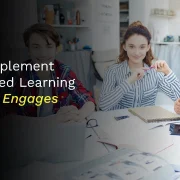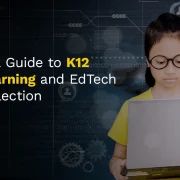
Effective 8 Interactive Learning Strategies in Education to Improve Academic Performance
Summary
This blog explores effective interactive learning strategies to engage K12 students in online education, including prioritizing active learning, setting clear goals, breaking lessons into chunks, fostering collaboration, valuing students, leveraging technology, and diversifying content delivery.
Creating an engaging online learning program is one of the keys to ensuring that the K-12 learners learn effectively. And one of the most powerful strategies to make learners more engaged in an online learning environment is to make it interactive.
Incorporating interactive learning strategies while designing the curriculum helps ensure that learners remain engaged and take an active role in their learning. In this blog, we explore some of the effective ways to engage K-12 students and make online learning programs more interactive for them.
Know More: Interactive Strategies for Online Learning & Engagement
Top Interactive Learning Strategies to Enhance K-12 education.
- Make active learning a priority
- Set clear goals for learners
- Break down the lesson into smaller chunks
- Let students choose the way
- Foster student collaboration with virtual breakout rooms
- Make your students feel valued
- Use technology to your advantage
- Plan for delivery diversity
1. Make active learning a priority
For K-12 students, staying focused in a long, boring lecture can be challenging. With online learning, it has become even harder. To navigate the situation effectively and improve students’ academic performance at the same time, taking your normal classroom practices and incorporating them into your virtual classroom would make a significant impact.
For instance, make it a priority to:
- Encourage student discussions
- Coordinate with other instructors to ensure there are adequate breaks between sessions
- Assign homework and group work regularly
- Make use of videos and other interactive learning techniques
2. Set clear goals for learners
One of the excellent ways to improve students’ academic performance is by introducing clear short-term goals into your online classroom. You can do this by ensuring that each lesson has a clear outline that you can share with your student in the beginning, so they know where they are in the learning process and the context for any learning activity they are doing.
Apart from this, to make sure that students remain engaged throughout, you can
- Think about various interactive learning strategies on how you might reward students for finishing tasks during a lesson.
- Try incorporating a lot of positive feedback, point-system, badges, games, simulations, and other fun learning activities your students would enjoy and participate in
- Have a dedicated hub where students can visit every day to find their assignments, projects, and other crucial announcements
3. Break down the lesson into smaller chunks
When it comes to online teaching, timing is very important. For K-12 learners especially, it is best to break up your online lessons differently than you would with face-to-face ones.
Some tips on how you can do this include-
- Maintain the pace and break down information into small, bite-sized, and easily digestible chunks
- Make sure to stay away from lengthy explanations and slides with too much text
- Add a variety of activity types to keep learners engaged and achieve better learning outcomes
Apart from this, give students additional time to process the material, alternate between high and low-intensity activities, and incorporate various breaks regularly throughout the school day.
Know More: Interactive Strategies for Online Learning & Engagement
4. Let students choose the way
To get students engaged in the program and improve their performance, give them the choice of selecting the topics and units. It allows them to pick out relevant content instantly and better engage with it.
While you can always guide them along the learning path with your recommendations as and when necessary, allowing them to choose the order in which they wish to learn topics empowers and engages the learner more, leading to better student outcomes.
5. Foster student collaboration with virtual breakout rooms
When teaching remotely, the importance of having students work together in pairs or teams during activities to complete a task or product is critical. This increases the importance of classroom strategies for interactive learning experience.
Incorporating such interactive learning strategies during online class engages students and enhances instruction the same way it does during in-person teaching.
To do this, you can use online platforms such as Zoom to place learners in breakout rooms at different points of the lesson. Depending on the purpose of the lesson, you can strategically or randomly choose groupings.
For instance, when students need to collaborate and partner for project work, group them purposefully for better outcomes. For other activities such as learning circles or turn and talk activities, they can be randomly assigned a partner.
Know More: Interactive Strategies in Videos for Student’s Engagement
6. Make your students feel valued
The isolation experienced by students when studying in online classrooms can impact their academic performance negatively and make them feel demotivated.
The best way instructors can help their students here is by making them feel valued in the classroom through interactive strategies in teaching.
Here is how you can do this-
- Consistently follow up on what you did in previous lessons
- Make an effort to find out about student’s interests and incorporate them into the lesson wherever possible
- Always aim to be positive and encouraging while interacting with students
- Give regular feedback on students’ work, assignments, etc.
Know More: Effective Interactive Learning Trends of Today
7. Use technology to your advantage
Delivering online lessons to K-12 learners comes with its unique set of challenges, but it also gives you a whole range of excellent tools to explore and make learning effective.
Whether you use virtual games, whiteboards, text editors, drawing tools, pointers, screen-sharing tools, or breakout rooms, you can leverage technology to add variety to your lessons and keep students engaged.
Further, you can also use social functions such as sharing and commenting on content for communicating with students. Combined with gamification, this makes any online course much more interactive and fun for learners.
WHITEPAPER:
Maximizing the ROI & Business Impact of Enterprise Learning
8. Plan for delivery diversity
To ensure a great online learning experience, engage learners using a mix of content delivery methods, including text, video, audio, and presentations.
In addition, allow students to make their voice heard by regularly asking for feedback on the learning experience and content. This will enable you to make adjustments in the course content along the way instead of waiting for the end of the course to do the same.
You can consider using short student surveys administered via simple tools such as Google Forms to ask questions such as-
- Is this online classroom easy to navigate?
- Are you having any technical issues?
Also Read: Making Online Classes More Engaging
Embracing the ongoing digital revolution and making the big leap into online classroom sessions for K-12 students can be an overwhelming experience. On top of that, the challenge of making these online classes interesting and engaging is even harder.
However, the virtual learning experience for K-12 students can be made more accessible and engaging with a digital mindset, the right tools, various interactive teaching strategies, and a focused approach.
By following the above tips, you can capture your students’ imagination, drive motivation and encourage participation, leading to better academic performance.
Contact us for more details!

Senior Vice President – Business Development
at Hurix Digital, with over 25 years of experience in EdTech and workforce learning. He excels in business development, customer relationship management, and scaling digital learning solutions, driving global growth through innovative content, simulations, and AI‑driven training offerings





